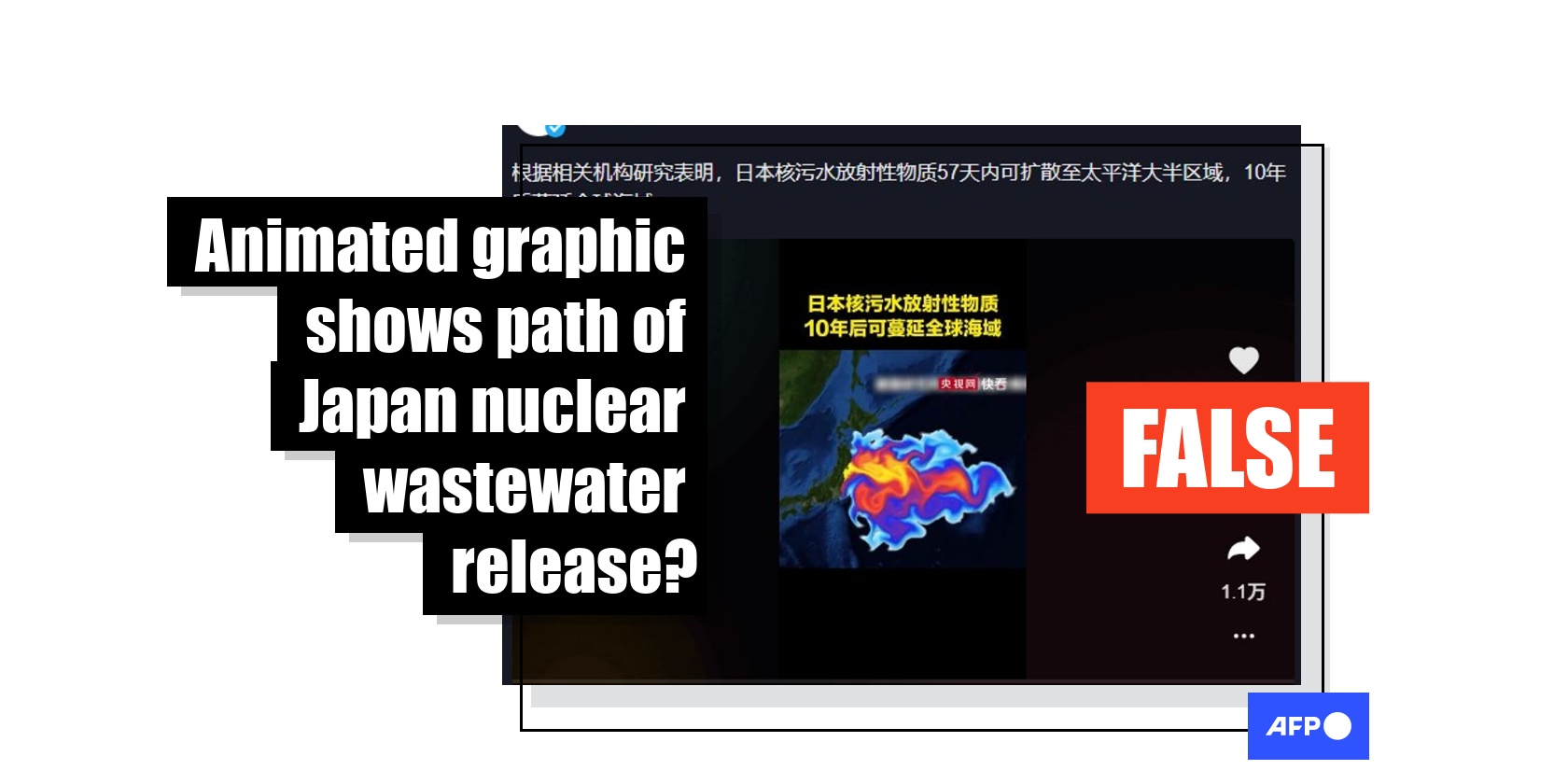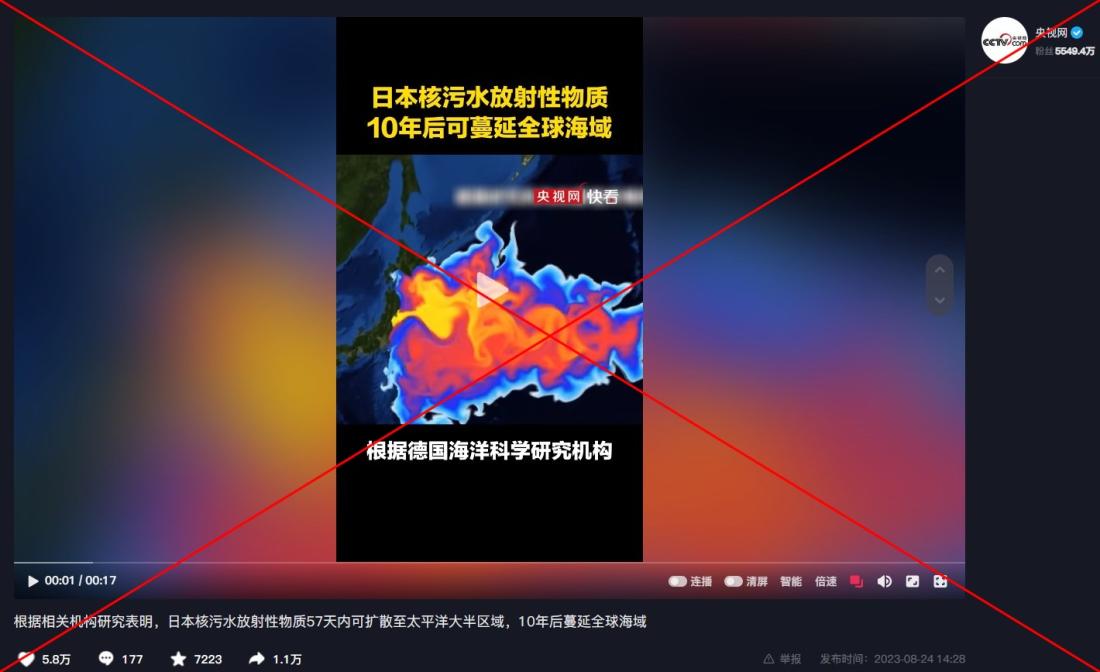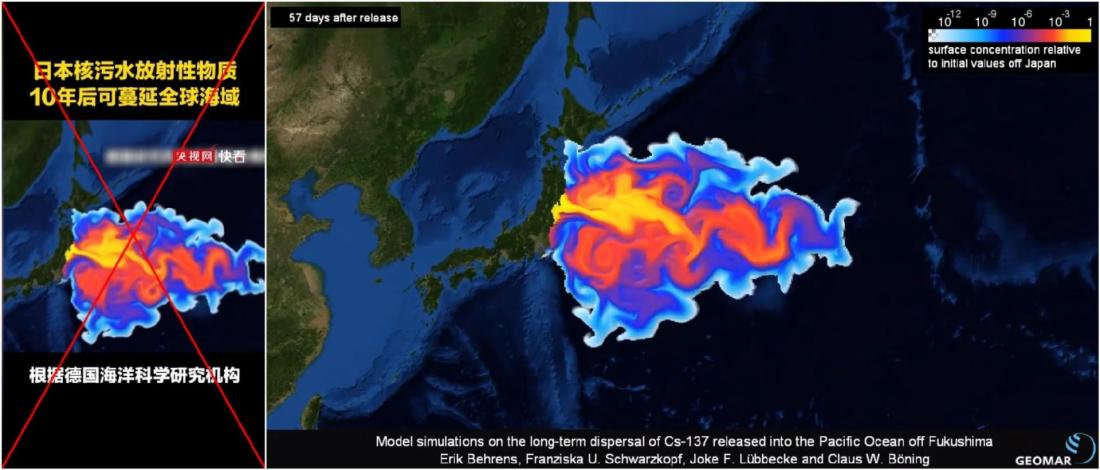
Old simulation graphic falsely linked to Fukushima wastewater release
- This article is more than two years old.
- Published on September 4, 2023 at 10:28
- Updated on September 5, 2023 at 06:12
- 4 min read
- By AFP Hong Kong
The graphic, which shows a highlighted current spreading out from Japan across a map of the Pacific, was shared by China's state broadcaster CCTV on Douyin on August 24, 2023.
"According to a study by a relevant institution, radioactive material from Japan's nuclear wastewater could spread to most of the Pacific Ocean in 57 days, and to global seawaters in 10 years' time," reads the caption written in simplified Chinese.
The video's narration claims the study is by a marine research institute in Germany, which found the strong currents off Fukushima would push wastewater from the nuclear plant to the United States and Canada within three years and spread globally in 10 years.
The post was shared on the same day Japan began releasing more than 500 Olympic swimming pools' worth of treated wastewater from the Fukushima nuclear plant into the Pacific, 12 years after one of the world's worst nuclear accidents.
The plan -- to be carried out over several decades -- has added to longstanding animosity with China, which has banned seafood imports from its neighbour despite reassurances from the UN atomic agency and Japanese authorities that the water is safe.

China's state-run foreign language news channel CGTN also included the animation in its reporting about the wastewater discharge, claiming it showed radioactive materials could "spread to most of the Pacific within 57 days from the date of discharge".
Social media users shared the animation alongside similar false claims on TikTok and its Chinese equivalent, Douyin, as well as Facebook, Weibo, WeChat, YouTube and X, formerly known as Twitter.
A Weibo hashtag that translates as "Japan's nuclear wastewater will contaminate half the Pacific Ocean in 57 days" has been viewed more than 700 million times.
But the model simulation was created in 2012 -- it was not made to predict long-term release scenarios and cannot be applied to the current discharge of wastewater from Fukushima, the study's author told AFP.
Misused models
Keyword and reverse image searches on Google found a journal article containing a video with the model simulation published on the official website of the Germany-based GEOMAR Helmholtz Centre for Ocean Research Kiel (archive links here and here).
The study is titled "Model simulations on the long-term dispersal of 137Cs released into the Pacific Ocean off Fukushima". The study's authors used a tracer element to model the spread of radioactive caesium-137 isotopes after the Fukushima nuclear meltdown (archived link).
Caesium-137 is one of the radionuclides of greatest concern to the food supply following a nuclear power plant accident (archived link).
The study concluded that ocean currents would effectively dilute the seawater contaminated by discharge from the stricken nuclear plant.
Below is a screenshot comparison of the model simulation shared in the false posts (left) and the original animation by the GEOMAR researchers (right):

"The animation produced as part of this study only captures the initial release of 137-Cs during the first few weeks after the meltdown occurred and was not made for any long-term release scenarios, nor can it be applied to those," Erik Behrens, one of the study's authors, told AFP on August 30 (archived link).
Behrens said he has not conducted any relevant research since.
Jim Smith, a professor of environmental science at the University of Portsmouth and who was not involved in the 2012 study, said: "I think it is misleading to refer to this as a simulation of the recent Fukushima release."
"This is simulating the original accident release which is completely different to the release of treated wastewater we are seeing today. The only thing that is similar is that the release point is approximately the same," Smith told AFP on August 26.
He added that sharing the 2012 simulation alongside reports about the wastewater release misleadingly implied there would be significant dispersion of caesium-137 and other radioactive elements across a large distance.
In fact, the Japanese Ministry of Environment has said caesium is one of the radioactive materials that is efficiently removed by the filtration and treatment system used at the Fukushima plant (archived link).
The IAEA says the advanced liquid processing system used to treat the water from the plant removes 62 radionuclides, except tritium (archived links here and here).
Smith said that even though the wastewater would spread widely, the radionuclide concentrations would be so low as to become undetectable once it reached distances of more than a few kilometres from the discharge point.
AFP has debunked other false claims about the Fukushima wastewater release here, here and here.
September 5, 2023 the Weibo posts with the hashtag did not necessarily feature the misleading graphic
Copyright © AFP 2017-2025. Any commercial use of this content requires a subscription. Click here to find out more.
Is there content that you would like AFP to fact-check? Get in touch.
Contact us
